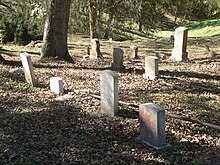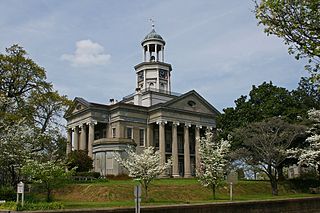
Vicksburg is a historic city in Warren County, Mississippi, United States. It is the county seat. The population was 21,573 at the 2020 census. Located on a high bluff on the east bank of the Mississippi River across from Louisiana, Vicksburg was built by French colonists in 1719. The outpost withstood an attack from the native Natchez people. It was incorporated as Vicksburg in 1825 after Methodist missionary Newitt Vick. The area that is now Vicksburg was long occupied by the Natchez Native Americans as part of their historical territory along the Mississippi. The first Europeans who settled the area were French colonists who built Fort Saint Pierre in 1719 on the high bluffs overlooking the Yazoo River at present-day Redwood. They conducted fur trading with the Natchez and others, and started plantations. During the American Civil War, it was a key Confederate river-port, and its July 1863 surrender to Ulysses S. Grant, along with the concurrent Battle of Gettysburg, marked the turning-point of the war.

The Battle of Champion Hill of May 16, 1863, was the pivotal battle in the Vicksburg Campaign of the American Civil War (1861–1865). Union Army commander Maj. Gen. Ulysses S. Grant and the Army of the Tennessee pursued the retreating Confederate States Army under Lt. Gen. John C. Pemberton and defeated it twenty miles to the east of Vicksburg, Mississippi, leading inevitably to the siege of Vicksburg and surrender. The battle is also known as Baker's Creek.
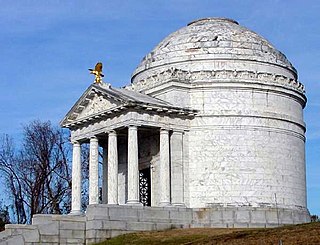
Vicksburg National Military Park preserves the site of the American Civil War Battle of Vicksburg, waged from March 29 to July 4, 1863. The park, located in Vicksburg, Mississippi, also commemorates the greater Vicksburg Campaign which led up to the battle. Reconstructed forts and trenches evoke memories of the 47-day siege that ended in the surrender of the city. Victory here and at Port Hudson, farther south in Louisiana, gave the Union control of the Mississippi River.

Little Rock National Cemetery is a United States National Cemetery, located approximately two miles (3 km) south-east of the Arkansas State Capitol Building, being within the city of Little Rock, and Pulaski County, Arkansas. It encompasses 31.7 acres (12.8 ha), and as of the end of 2005, had 25,172 interments. Administered by the United States Department of Veterans Affairs, it is currently closed to new interments.
The Confederate Memorial State Historic Site is a state-owned property occupying approximately 135 acres (55 ha) near Higginsville, Missouri. From 1891 to 1950, the site was used as an old soldiers' home for veterans of the Confederate States Army after the American Civil War. The Missouri state government then took over operation of the site after the last veteran died in 1950, using it as a state park. In 1981, a cottage, a chapel, and the Confederate cemetery were listed on the National Register of Historic Places as the Confederate Chapel, Cemetery and Cottage. The chapel was moved from its original position in 1913, but was returned in 1978. It has a tower and a stained glass window. The cottage is a small wooden building, and the cemetery contains 723 graves. Within the cemetery is a monument erected by the United Daughters of the Confederacy which is modeled on the Lion of Lucerne. In addition to the cemetery and historic structures, the grounds also contain trails, picnic sites, and fishing ponds.

Oakland Memorial Chapel is a historic church and academic building on the campus of Alcorn State University in rural southwestern Claiborne County, Mississippi. Built in 1838 as part of Oakland College, it is one of the oldest surviving buildings at Alcorn State, which took over that defunct school's campus after the American Civil War. Alcorn State was the first land grant university established specifically for the education of African Americans. The chapel was designated a National Historic Landmark in 1976, and was designated a Mississippi Landmark in 1985.
The Port Gibson Battlefield is the site near Port Gibson, Mississippi where the 1863 Battle of Port Gibson was fought during the American Civil War. The battlefield covers about 3,400 acres (1,400 ha) of land west of the city, astride Rodney Road, where Union Army forces were establishing a beachhead after crossing the Mississippi River in a bid to take the Confederate fortress of Vicksburg. The Union victory secured that beachhead and paved the way for the eventual fall of Vicksburg. A 2,080-acre (840 ha) area surrounding part of the site was listed on the National Register of Historic Places in 1972, and a larger area was designated a National Historic Landmark in 2005. In 2009, the battlefield was designated by the Civil War Preservation Trust as one of its Top 10 most endangered Civil War battlefields. In 2011, the Civil War Preservation Trust was renamed the Civil War Trust, which in 2018 became a division of the American Battlefield Trust. The Trust and its partners have acquired and preserved 644 acres (2.61 km2) of the Port Gibson battlefield.
The Port Hudson State Historic Site is located on the Mississippi River north of Baton Rouge in East Feliciana Parish, Louisiana, just outside the limits of Port Hudson and in the vicinity of Jackson. The site preserves a portion of the fortifications and battle area of the longest siege in American history, during the American Civil War from May 23 through July 9, 1863. The state of Louisiana maintains the site, which includes a museum about the siege, artillery displays, redoubts, and interpretive plaques. Historical reenactments are held each year. It was designated a National Historic Landmark in 1974, significant as the first place where African-American military units fought for the Union Army under African-American field leadership.
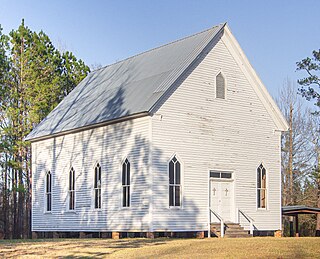
Zion Baptist Church in Collinsville, Mississippi is a Carpenter Gothic church built in 1910–11. It was listed on the National Register of Historic Places (NRHP) in 2002.

There are nine historic districts in Meridian, Mississippi. Each of these districts is listed on the National Register of Historic Places. One district, Meridian Downtown Historic District, is a combination of two older districts, Meridian Urban Center Historic District and Union Station Historic District. Many architectural styles are present in the districts, most from the late 19th century and early 20th century, including Queen Anne, Colonial Revival, Italianate, Art Deco, Late Victorian, and Bungalow.

Congregation Beth Israel is a Reform Jewish congregation and synagogue, located in Meridian, Mississippi, in the United States. Founded in 1868 and a member of the Union for Reform Judaism, the congregation's first permanent house of worship was a Middle Eastern-style building constructed in 1879. The congregation moved to another building built in the Greek Revival style in 1906, and in 1964 moved to a more modern building, out of which they still operate.

The Odd Fellows Cemetery in Starkville, Mississippi is a historic, 3-acre (1.2 ha) African-American cemetery that was listed on the National Register of Historic Places in 1990.

The Holy Family Catholic Church Historic District, in Natchez, Mississippi, is a 9.2-acre (3.7 ha) historic district that was listed on the U.S. National Register of Historic Places (NRHP) in 1995.

Newtown Cemetery is a historic cemetery in Harrisonburg, Virginia. It is located in the northern part of the city, bounded on the north by Kelley Street and the west by Sterling Street. It is bisected by an extension of Effinger Street, which now serves as part of the cemetery's circulation roads. The roughly 4-acre (1.6 ha) parcel has been the primary burial ground for the city's African-American dead since its founding in 1869. It is estimated to hold 900 graves, including many of emancipated slaves. Notable burials include educator Lucy F. Simms and veterans of the US Colored Troops.
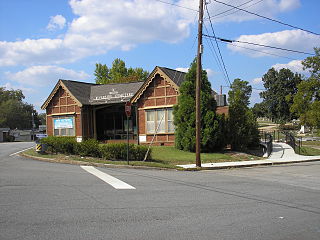
Riverside Cemetery is a historic rural cemetery in Macon, Georgia established in 1887. It is approximately 54 acres (22 ha) in size and privately owned. Over 18,000 people are interred here.
Harvey Alex Shannon was an American medical doctor, state legislator, and newspaper publisher in Vicksburg, Mississippi.

The Anshe Chesed Cemetery is a historic Jewish cemetery located in Vicksburg, Mississippi, U.S.. It is located adjacent to the Vicksburg National Military Park, however it is set apart by a line of trees and has its entrance on Grove Street. It is listed on the National Register of Historic Places since September 10, 2014.

